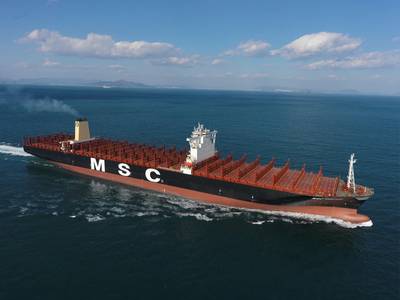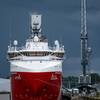DNV GL welcomed the world’s largest containership, MSC Oscar, into class. Delivered in January by Daewoo Shipbuilding & Marine Engineering (DSME) in Geoje, South Korea, the 19,224 TEU vessel has already entered service on the line’s new East-West service.
The newest ship for MSC Mediterranean Shipping Company has set a size benchmark for containerships in terms of capacity, and has also been designed with a number of efficiency enhancing features; for example, the engine has been optimized so that fuel consumption can be automatically controlled to take into account both speed and weather conditions and she has a broad optimal speed range for enhanced operational flexibility.
“For over 40 years the MSC family has been growing – and so too has our fleet,“ said Diego Aponte, MSC President and CEO. “Our partnership with DNV GL continues to be an important part of our journey. Today we are proud to own the largest container vessel on the seas, the MSC Oscar, which adds to our solid reputation as a leading ocean carrier. She will soon be joined by sister ship MSC Oliver, built to the same demanding class regulations, which marks yet another milestone in our ongoing relationship with DNV GL.”
DNV GL noted that the loading capacity of container vessels has more than tripled in less than 20 years, with the length of the biggest vessels jumping from just over 300 to 400m during that time. MSC Oscar measures 395.4m long and 59m wide with a draft of 16m. Initially specified at 18,000 TEU, MSC Oscar was expanded during the building phase to add an extra tier above decks. The containership is unique in its wide beam design and use of torsion box and hatch coaming plates with steel plate thickness up to 100mm. The vessel is able to carry dangerous goods in holds, and approximately 1,800 reefer containers.
The vessel’s cargo capacity has also been enhanced by implementing the RSCS class notation (Route Specific Container Stowage). The RSCS notation was developed by DNV GL to provide an even more efficient usage of cargo capacity with more flexibility for laden containers on board for specific routes while not compromising on safety.
The vessel was constructed in 11 months, from steel cutting to delivery, including commissioning and sea trials. MSC Oscar is the first of the series of six ultra large containerships (ULCS) of Olympic Series. The remaining sister vessels of the series are expected to be completed by November 2015.
The cooperation between MSC and DNV GL stretches back to some of MSC’s first vessels. In 2005 the company’s first entry into the large boxship market, the 9,000TEU MSC Pamela, was built to DNV GL class rules.
Today, MSC has 18 more vessels of over 19,000TEU on order, deliveries which could move MSC into the position of being the largest container shipping line in the world. The next of these vessels, MSC Oliver, also with DNV GL class, is expected for delivery in April.
DNV GL said it has been the “class of choice” for shipowners in the ULCS segment, with most of the world’s largest vessels being constructed according to DNV GL rules.











